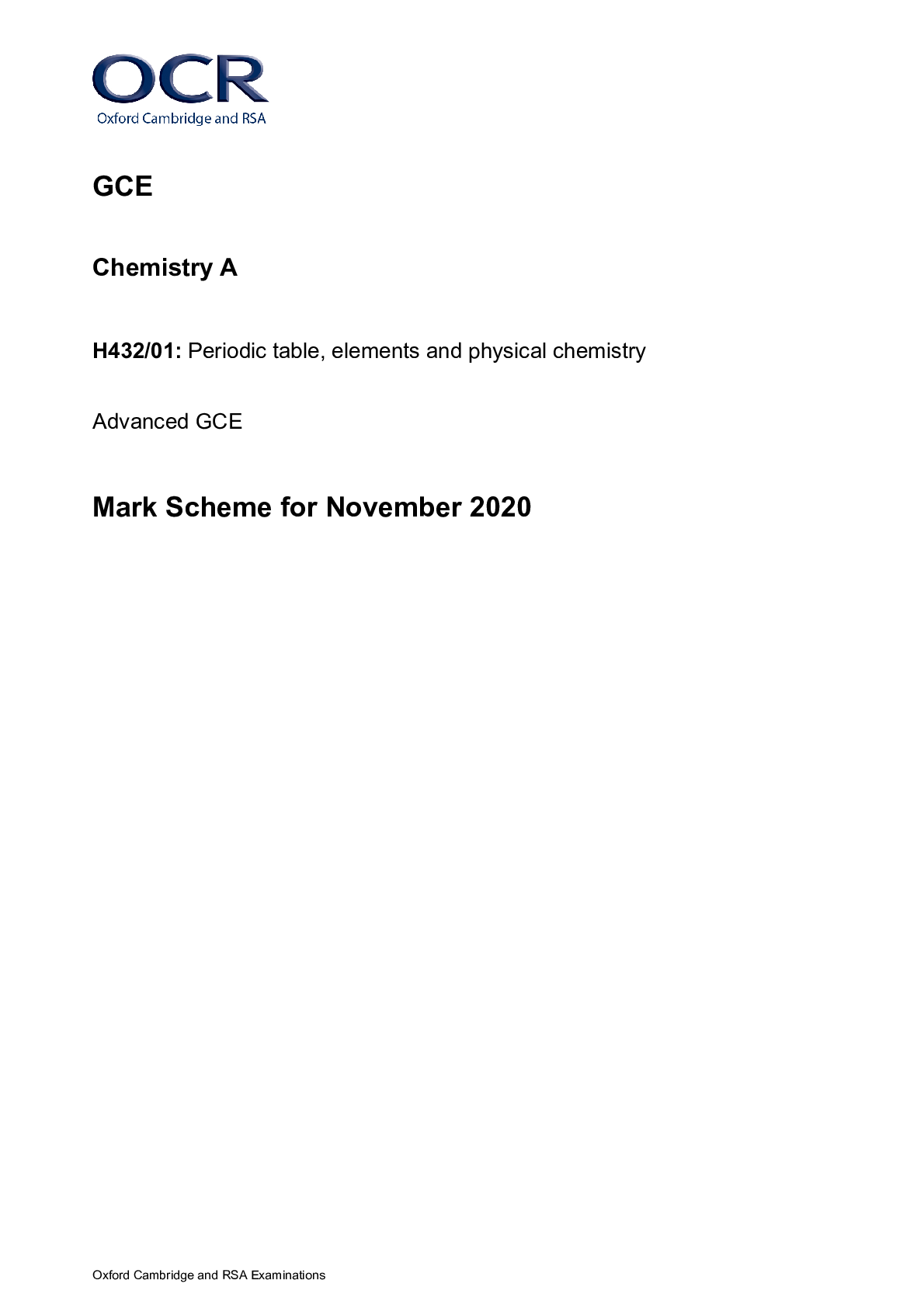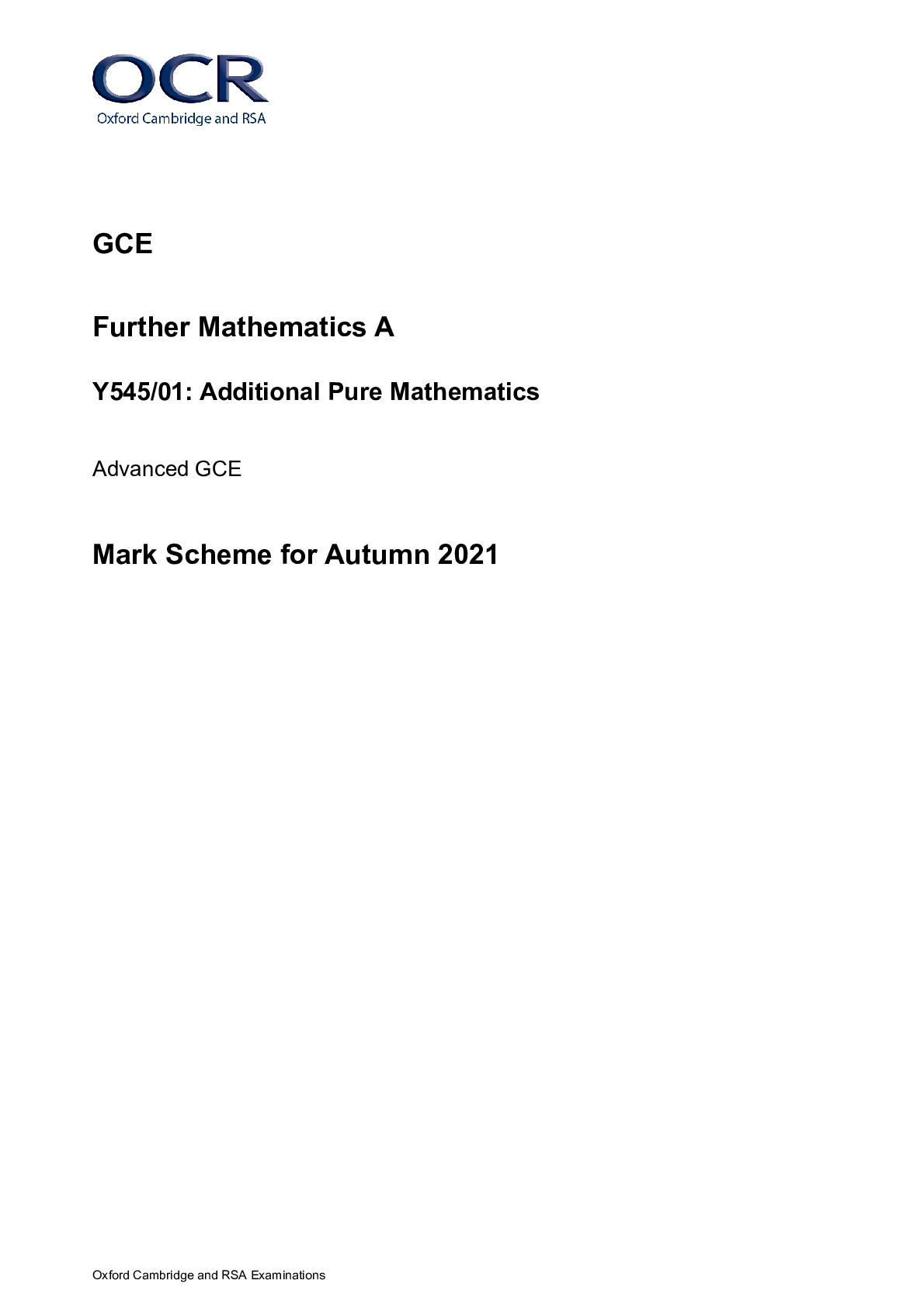Mathematics > AS Mark Scheme > GCE Further Mathematics B (MEI) Y413/01: Modelling with algorithms Advanced Subsidiary GCE Mark Sche (All)
GCE Further Mathematics B (MEI) Y413/01: Modelling with algorithms Advanced Subsidiary GCE Mark Scheme for November 2020
Document Content and Description Below
Oxford Cambridge and RSA Examinations GCE Further Mathematics B (MEI) Y413/01: Modelling with algorithms Advanced Subsidiary GCE Mark Scheme for November 2020Oxford Cambridge and RSA Examinations... OCR (Oxford Cambridge and RSA) is a leading UK awarding body, providing a wide range of qualifications to meet the needs of candidates of all ages and abilities. OCR qualifications include AS/A Levels, Diplomas, GCSEs, Cambridge Nationals, Cambridge Technicals, Functional Skills, Key Skills, Entry Level qualifications, NVQs and vocational qualifications in areas such as IT, business, languages, teaching/training, administration and secretarial skills. It is also responsible for developing new specifications to meet national requirements and the needs of students and teachers. OCR is a not-for-profit organisation; any surplus made is invested back into the establishment to help towards the development of qualifications and support, which keep pace with the changing needs of today’s society. This mark scheme is published as an aid to teachers and students, to indicate the requirements of the examination. It shows the basis on which marks were awarded by examiners. It does not indicate the details of the discussions which took place at an examiners’ meeting before marking commenced. All examiners are instructed that alternative correct answers and unexpected approaches in candidates’ scripts must be given marks that fairly reflect the relevant knowledge and skills demonstrated. Mark schemes should be read in conjunction with the published question papers and the report on the examination. © OCR 2020Y413/01 Mark Scheme November 2020 Text Instructions Annotations and abbreviations Annotation in scoris Meaning and BOD Benefit of doubt FT Follow through ISW Ignore subsequent working M0, M1 Method mark awarded 0, 1 A0, A1 Accuracy mark awarded 0, 1 B0, B1 Independent mark awarded 0, 1 E Explanation mark 1 SC Special case ^ Omission sign MR Misread BP Blank page Highlighting Other abbreviations in mark scheme Meaning E1 Mark for explaining a result or establishing a given result dep* Mark dependent on a previous mark, indicated by *. The * may be omitted if only previous M mark. cao Correct answer only oe Or equivalent rot Rounded or truncated soi Seen or implied www Without wrong working AG Answer given awrt Anything which rounds to BC By Calculator DR This indicates that the instruction In this question you must show detailed reasoning appears in the question.Y413/01 Mark Scheme November 2020 13 Subject-specific Marking Instructions for AS Level Mathematics B (MEI) a Annotations must be used during your marking. For a response awarded zero (or full) marks a single appropriate annotation (cross, tick, M0 or ^) is sufficient, but not required. For responses that are not awarded either 0 or full marks, you must make it clear how you have arrived at the mark you have awarded and all responses must have enough annotation for a reviewer to decide if the mark awarded is correct without having to mark it independently. It is vital that you annotate standardisation scripts fully to show how the marks have been awarded. Award NR (No Response) - if there is nothing written at all in the answer space and no attempt elsewhere in the script - OR if there is a comment which does not in any way relate to the question (e.g. ‘can’t do’, ‘don’t know’) - OR if there is a mark (e.g. a dash, a question mark, a picture) which isn’t an attempt at the question. Note: Award 0 marks only for an attempt that earns no credit (including copying out the question). If a candidate uses the answer space for one question to answer another, for example using the space for 8(b) to answer 8(a), then give benefit of doubt unless it is ambiguous for which part it is intended. b An element of professional judgement is required in the marking of any written paper. Remember that the mark scheme is designed to assist in marking incorrect solutions. Correct solutions leading to correct answers are awarded full marks but work must not always be judged on the answer alone, and answers that are given in the question, especially, must be validly obtained; key steps in the working must always be looked at and anything unfamiliar must be investigated thoroughly. Correct but unfamiliar or unexpected methods are often signalled by a correct result following an apparently incorrect method. Such work must be carefully assessed. When a candidate adopts a method which does not correspond to the mark scheme, escalate the question to your Team Leader who will decide on a course of action with the Principal Examiner. If you are in any doubt whatsoever you should contact your Team Leader.Y413/01 Mark Scheme November 2020 c The following types of marks are available. M A suitable method has been selected and applied in a manner which shows that the method is essentially understood. Method marks are not usually lost for numerical errors, algebraic slips or errors in units. However, it is not usually sufficient for a candidate just to indicate an intention of using some method or just to quote a formula; the formula or idea must be applied to the specific problem in hand, e.g. by substituting the relevant quantities into the formula. In some cases the nature of the errors allowed for the award of an M mark may be specified. A method mark may usually be implied by a correct answer unless the question includes the DR statement, the command words “Determine” or “Show that”, or some other indication that the method must be given explicitly. A Accuracy mark, awarded for a correct answer or intermediate step correctly obtained. Accuracy marks cannot be given unless the associated Method mark is earned (or implied). Therefore M0 A1 cannot ever be awarded. B Mark for a correct result or statement independent of Method marks. E A given result is to be established or a result has to be explained. This usually requires more working or explanation than the establishment of an unknown result. Unless otherwise indicated, marks once gained cannot subsequently be lost, e.g. wrong working following a correct form of answer is ignored. Sometimes this is reinforced in the mark scheme by the abbreviation isw. However, this would not apply to a case where a candidate passes through the correct answer as part of a wrong argument. d When a part of a question has two or more ‘method’ steps, the M marks are in principle independent unless the scheme specifically says otherwise; and similarly where there are several B marks allocated. (The notation ‘dep*’ is used to indicate that a particular mark is dependent on an earlier, asterisked, mark in the scheme.) Of course, in practice it may happen that when a candidate has once gone wrong in a part of a question, the work from there on is worthless so that no more marks can sensibly be given. On the other hand, when two or more steps are successfully run together by the candidate, the earlier marks are implied and full credit must be given. e The abbreviation FT implies that the A or B mark indicated is allowed for work correctly following on from previously incorrect results. Otherwise, A and B marks are given for correct work only – differences in notation are of course permitted. A (accuracy) marks are not given for answers obtained from incorrect working. When A or B marks are awarded for work at an intermediate stage of a solution, there may be various alternatives that are equally acceptable. In such cases, what is acceptable will be detailed in the mark scheme. If this is not the case, please escalate the question to your Team Leader who will decide on a course of action with the Principal Examiner. Sometimes the answer to one part of a question is used in a later part of the same question. In this case, A marks will often be ‘follow through’. In such cases you must ensure that you refer back to the answer of the previous part question even if this is not shown within the image zone. You may find it easier to mark follow through questions candidate-by-candidate rather than question-by-question.Y413/01 Mark Scheme November 2020 13 f Unless units are specifically requested, there is no penalty for wrong or missing units as long as the answer is numerically correct and expressed either in SI or in the units of the question. (e.g. lengths will be assumed to be in metres unless in a particular question all the lengths are in km, when this would be assumed to be the unspecified unit.) We are usually quite flexible about the accuracy to which the final answer is expressed; over-specification is usually only penalised where the scheme explicitly says so. • When a value is given in the paper only accept an answer correct to at least as many significant figures as the given value. • When a value is not given in the paper accept any answer that agrees with the correct value to 2 s.f. unless a different level of accuracy has been asked for in the question, or the mark scheme specifies an acceptable range. NB for Specification A the rubric specifies 3 s.f. as standard, so this statement reads “3 s.f” Follow through should be used so that only one mark in any question is lost for each distinct accuracy error. Candidates using a value of 9.80, 9.81 or 10 for g should usually be penalised for any final accuracy marks which do not agree to the value found with 9.8 which is given in the rubric. g Rules for replaced work and multiple attempts: • If one attempt is clearly indicated as the one to mark, or only one is left uncrossed out, then mark that attempt and ignore the others. • If more than one attempt is left not crossed out, then mark the last attempt unless it only repeats part of the first attempt or is substantially less complete. • if a candidate crosses out all of their attempts, the assessor should attempt to mark the crossed out answer(s) as above and award marks appropriately. h For a genuine misreading (of numbers or symbols) which is such that the object and the difficulty of the question remain unaltered, mark according to the scheme but following through from the candidate’s data. A penalty is then applied; 1 mark is generally appropriate, though this may differ for some units. This is achieved by withholding one A or B mark in the question. Marks designated as cao may be awarded as long as there are no other errors. If a candidate corrects the misread in a later part, do not continue to follow through. E marks are lost unless, by chance, the given results are established by equivalent working. Note that a miscopy of the candidate’s own working is not a misread but an accuracy error. i If a calculator is used, some answers may be obtained with little or no working visible. Allow full marks for correct answers provided that there is nothing in the wording of the question specifying that analytical methods are required such as the bold “In this question you must show detailed reasoning”, or the command words “Show” and “Determine. Where an answer is wrong but there is some evidence of method, allow appropriate method marks. Wrong answers with no supporting method score zero. If in doubt, consult your Team Leader. j If in any case the scheme operates with considerable unfairness consult your Team Leader.Y413/01 Mark Scheme November 2020 Question Answer Marks AOs Guidance 1 (a) M1 A1 A1 1.1 1.1 1.1 Activity on arc + A, B, C, D, E correct and one start Both dummies correct (dummy for the uniqueness of G and H can be at the end of H or at the start of G or H) F, G, H, I and one finish Max. 2 marks if any arrows missing [3] 1 (b) Non-critical activities: E, G and H B1 1.1 These three activities and no others [1] A C E G I D F H BY413/01 Mark Scheme November 2020 13 2 (a) B1 1.1 cao [1] 2 (b) Maximise B1 + B2 + C2 + C3 + D1 + D2 + E3 + E4 + F3 + F5 B1 3.3 Correct objective function – including ‘Maximise’ (oe – e.g. Max.) B1 3.3 Constraints for the arcs from the left-hand set B1 D1 1, B2 C2 D2 1, C3 E3 F3 1, E4 1, F5 1 + ≤ + + ≤ + + ≤ ≤ ≤ B1 3.3 Constraints for the arcs from the right-hand set [3] 2 (c) (i) Maximal matching: B = 1, C = 3, D = 2, E = 4, F = 5 B1 1.1 cao [1] 2 (c) (ii) Solution is not unique e.g. B = 2, C = 3, D = 1, E = 4, F = 5 B1 1.1 Not unique (oe) + correct alternate matching shown or described (e.g. B and D could switch) [1] B1 B2 1, C2 C3 1, D1 D2 1, E3 E4 1, F3 F5 1 + ≤ + ≤ + ≤ + ≤ + ≤ B 1 C 2 D 3 E 4 F 5Y413/01 Mark Scheme November 2020 3 (a) Bin 1: 32 37 Bin 2: 25 18 27 Bin 3: 34 15 Bin 4: 30 M1 A1 1.1 1.1 First five numbers placed correctly cao [2] 3 (b) Comparisons Swaps 1st pass 1 1 2nd pass 1 0 3rd pass 1 0 4th pass 4 3 5th pass 3 2 6th pass 1 0 7th pass 5 4 M1 A1 A1 1.1 1.1 1.1 Number of comparisons either equal to or one greater than the number of swaps Cao (Comparisons) Cao (Swaps) [3] SC: If M0 then B2 for all but one pass correct, B1 for all but two passes correct 3 (c) Bin 1: 37 32 Bin 2: 34 30 Bin 3: 27 25 18 Bin 4: 15 M1 A1 1.1 1.1 First four numbers placed correctly cao [2] 3 (d) Complexity of order n B1 1.1 [1]Y413/01 Mark Scheme November 2020 13 4 (a) B1 1.2 cao – any simply connected graph with five vertices in which the order of the nodes are 1, 1, 2, 2 and 4 [1] 4 (b) (i) Minimum number of arcs = 6 B1 1.1 cao [1] (ii) Maximum number of arcs = 21 B1 1.1 cao [1] 4 (c) M1 1.1 At least five 1’s and at least two 2’s correct A B C D E A1 1.1 cao [2] 4 (d) Sum of the order of the vertices = 2(number of arcs) Therefore number of arcs = M1 2.1 Use of (oe) therefore graph cannot be a tree A1 2.2a Correct proof that graph is not a tree oe e.g. so the number of arcs is (15 + x)/2, which is at least 8 but a tree on seven vertices has six arcs. [2] A 0 1 0 0 2 B 1 0 1 0 1 C 0 1 0 2 1 D 0 0 2 2 1 E 2 1 1 1 0 15 2 + x ∑order of arcs = twice the number of arcs 15 6 12 15 0 2 x x + = ⇒ = − <Y413/01 Mark Scheme November 2020 5 (a) The only flow into B is from arc SB which has a maximum capacity of 47 but the maximum capacity of the flow out of BA, BC and BE is 14 + 15 + 16 = 45 B1 2.4 [1] 5 (b) [Capacity of the cut is] 160 B1 1.1 [1] 5 (c) M1 A1 1.1 1.1 Consistent flow pattern (flow in = flow out at each node) – one number on each arc. BA = 14, BC = 15, BE = 16, DG = 12, DF = 13, ET = 58 Condone incorrect flow across one vertex for the M mark [2] 5 (d) The capacity of the cut which partitions the vertices into the sets {S, A, B, D}, {C, E, F, G, T} is 12 + 13 + 17 + 10 + 33 +15 + 16 = 116 minimum cut is M1 2.3 By the maximum flow-minimum cut theorem the maximum flow is equal to the minimum cut and so therefore the maximum flow through the system is 116 litres per hour A1 2.1 [2] α ∴ ≤116 D F C S 17 58 33 13 42 0 17 5 12 8 25 33 38 15 16 14 10 45 A B E G TY413/01 Mark Scheme November 2020 13 5 (e) The capacity of SC should be increased as this is the only saturated arc from the source B1 3.4 Correct arc + reasoning (must include mention that SC is saturated in current maximum flow) Alternative: stating backwards from T and using the fact that CT is not saturated and that the only way to get from S to C is by increasing the capacity of one arc from S is by using SC SC can be increased by 8 to 41 as it can be increased to the capacity of CT M1 A1 1.1 2.4 Correct new capacity Must mention CT Maximum possible flow is now 124 B1 2.2a cao [4]Y413/01 Mark Scheme November 2020 6 (a) Arc Weight AB 24 AC 15 AE 52 BD 32 BE 23 CE 35 CF 17 DE 12 DG 16 EF 10 EH 21 FG 45 FH 38 GH - B1 B1 B1 B1 1.1 1.1 1.1 1.1 AB, AE, AC CF, EF, DE, DG BD, CE, FG, FH BE, EH and GH blank [4] 6 (b) The weight of GH must be at least 7 because if it was less than 7 then the final value at G would have been less than 70 B1 3.4 If no marks in (b) then SC B1 for either GH 21 < or GH 7 ≥ As GH is in the MST and EH and FH aren’t this implies that the weight of GH < the weight of both EH and FH B1 3.1b B1 2.2a [3] 6 (c) Weight of GH is 11 B1 1.1 [1] 7 GH < 21 ≤Y413/01 Mark Scheme November 2020 13 7 (a) B1 3.3 B1 3.3 oe e.g. B1 3.3 M1 3.1a Allow incorrect placement of the 0.4 or inequality sign the wrong way round (but not both) A1 1.1 P x y z RHS 1 0 0 0 0 0 5 10 20 1 0 0 1750 0 1 1 1 0 1 0 150 0 2 2 0 0 1 0 M1 A1 1.1 1.1 Any two rows correct following through their equations Cao (or equivalent e.g. rows in different orders, scaled constraints (that is a row scaled apart from the slack variable)) [7] 7 (b) There is still a negative entry in the objective row B1 2.4 [1] 7 (c) P x y z RHS 1 0 0 0 750 0 1 0 0 50 0 0 0 1 25 0 0 1 0 75 M1 A1 A1 3.4 1.1 1.1 Pivot row and column correct (condone a slip on pivot row) – allow non-exact values Any non-zero or 1 column correct cao [3] 7 (d) (i) 60 small tents, 35 medium tents and 55 large tents B1 3.2a Must be in context [1] (d) (ii) £79 500 B1 1.1 cao [1] P x y z P x y z = + + ⇒ − − − = 3 5 8 3 5 8 0 5 10 20 1750 5 10 20 1750 x y z x y z s + + ≤ ⇒ + + + = 1 x y z s + + + = 2 4 350 1 x y z x y z s + + ≤ ⇒ + + + = 150 2 150 0.4( x y z x + + ≤ ) ⇒ − + + + = 3 2 2 0 x y z s3 s1 s2 s3 −3 −5 −8 −3 s1 s2 s3 97 − 15 7 27 − 27 − 17 27 − 57 5 − 14 3 14 47 3 14 1 14Y413/01 Mark Scheme November 2020 7 (e) This additional constraint is that and the simplex method can only be used to solve non-trivial constraints of the form where B1 3.5b [1] 7 (f) B1 3.1a B1 3.5c where Q is the new objective to be minimised, is a surplus variable and is an artificial variable B1 2.5 [3] x y + ≥100 ax by cz d + + ≤ d ≥ 0 x y x y s a + ≥ ⇒ + − + = 100 4 1 100 Q x y s + + − = 4 100 s4 a1OCR (Oxford Cambridge and RSA Examinations) The Triangle Building Shaftesbury Road Cambridge CB2 8EA [Show More]
Last updated: 1 year ago
Preview 1 out of 16 pages
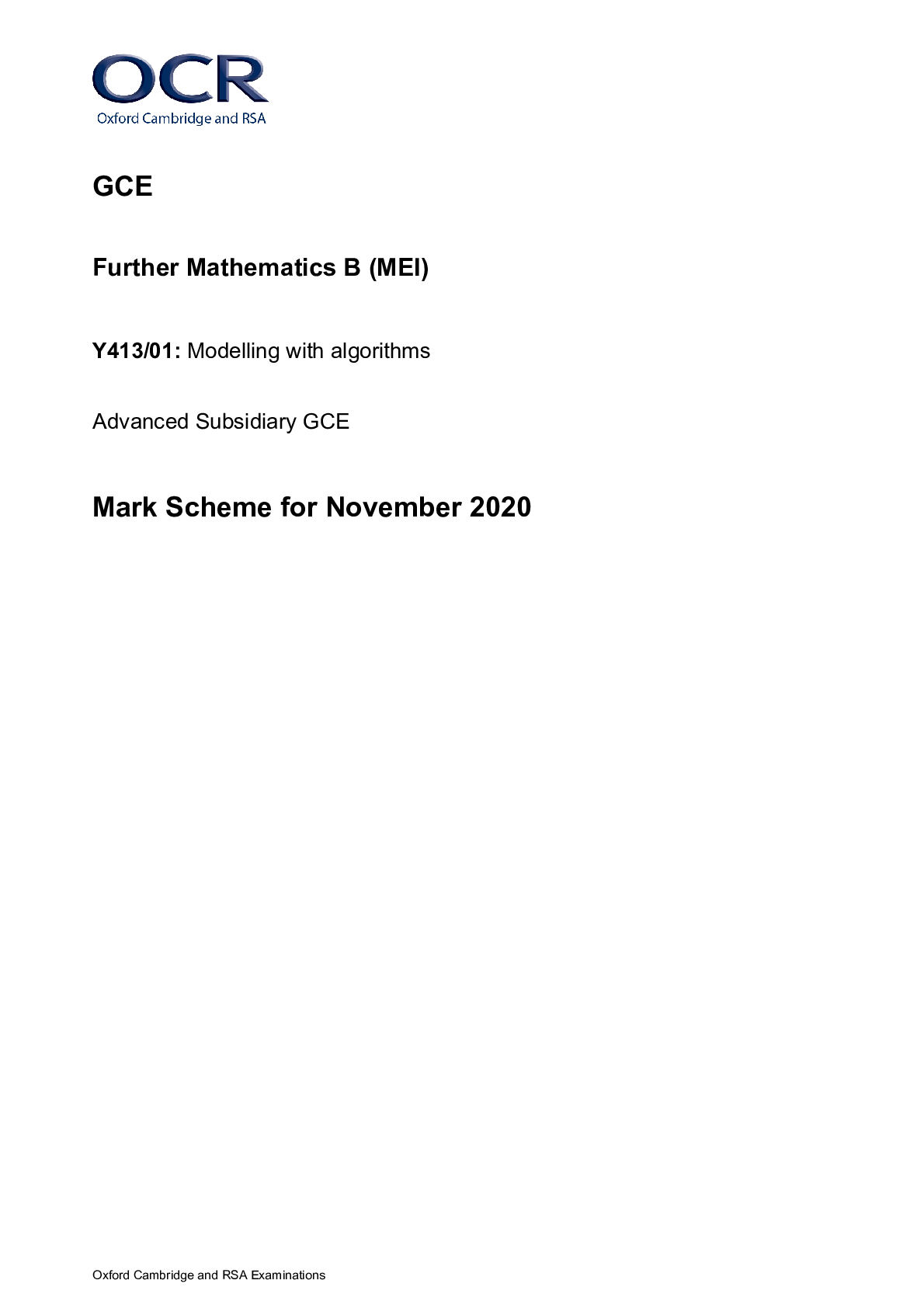
Reviews( 0 )
Document information
Connected school, study & course
About the document
Uploaded On
Oct 10, 2022
Number of pages
16
Written in
Additional information
This document has been written for:
Uploaded
Oct 10, 2022
Downloads
0
Views
38

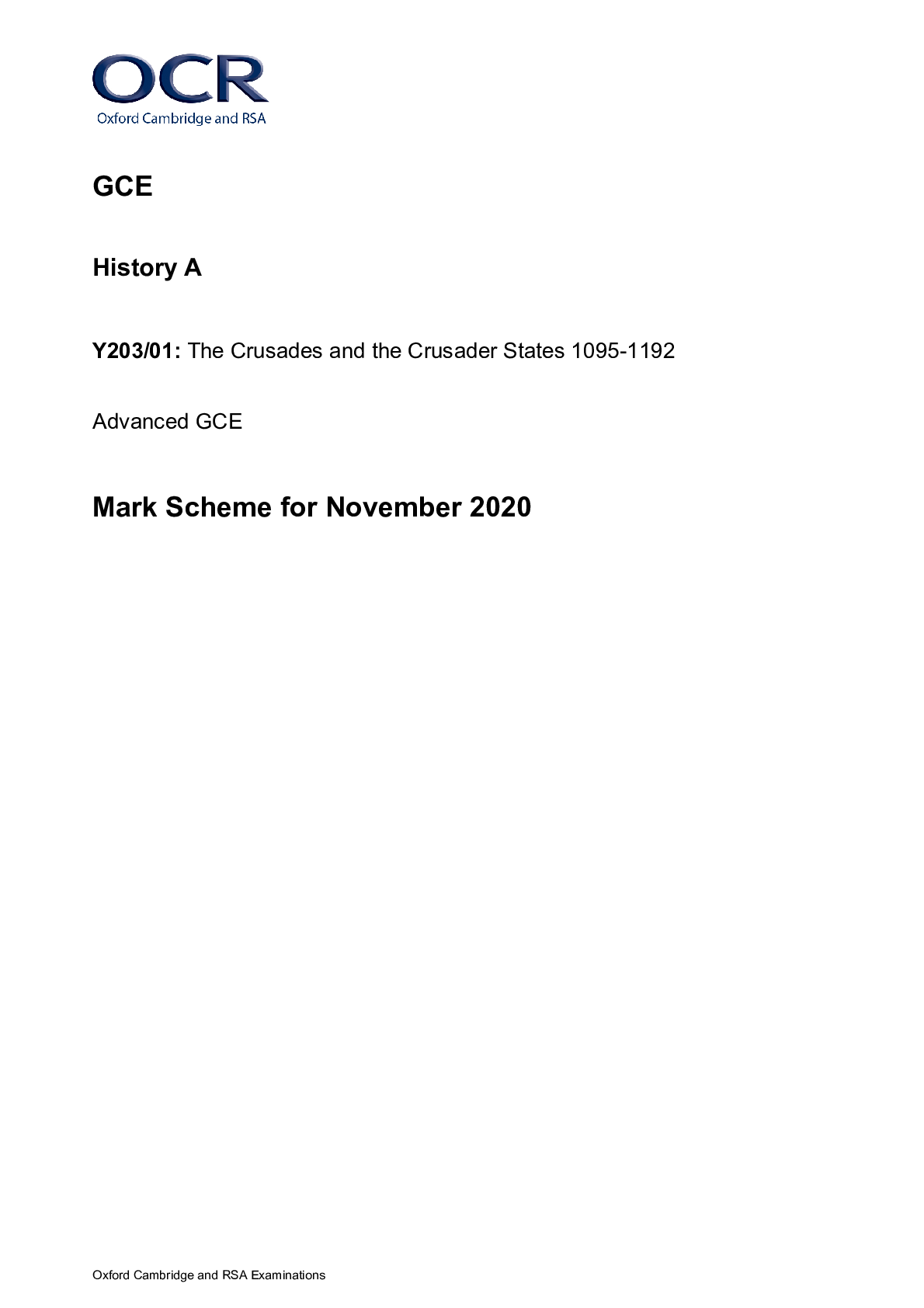
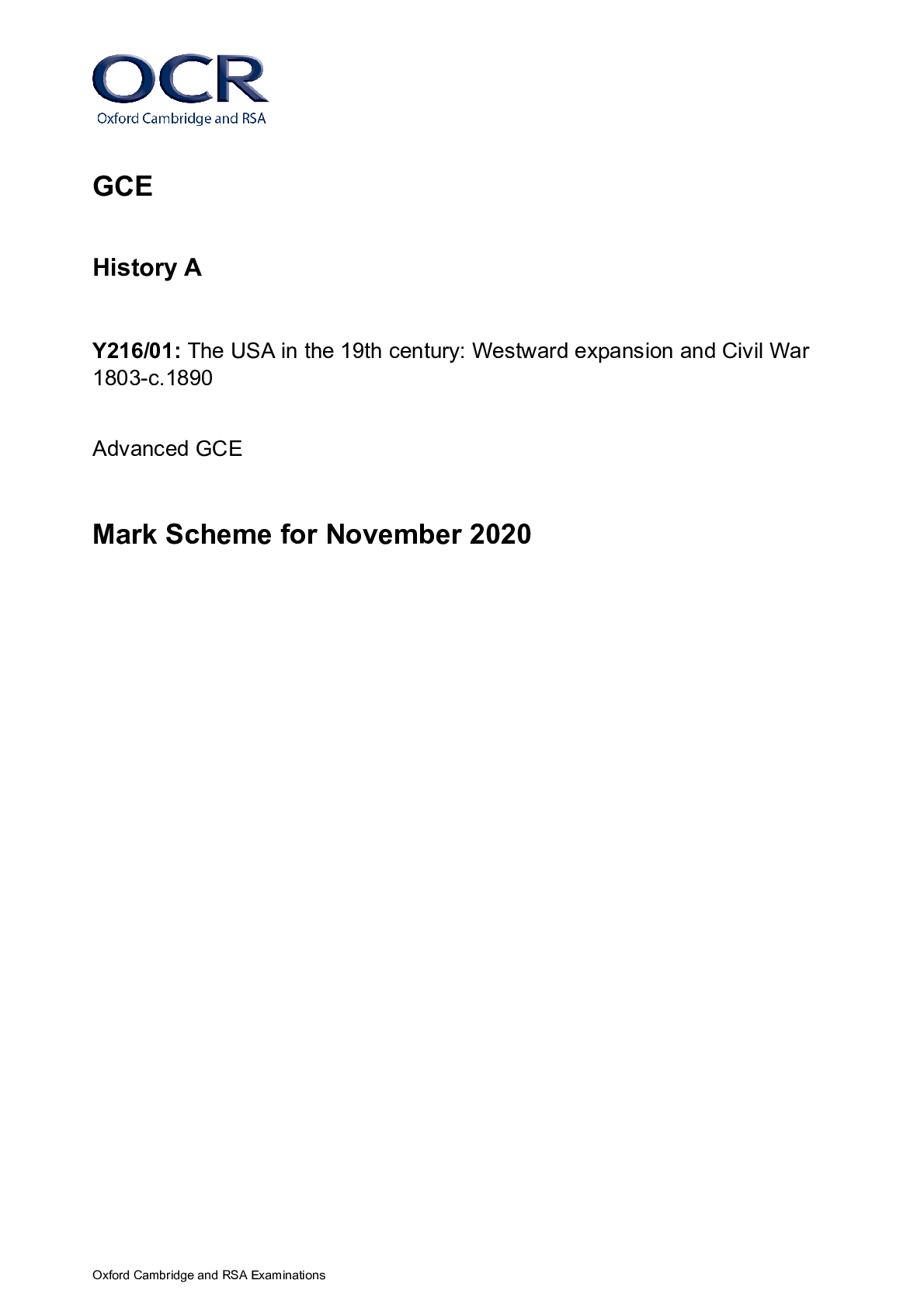
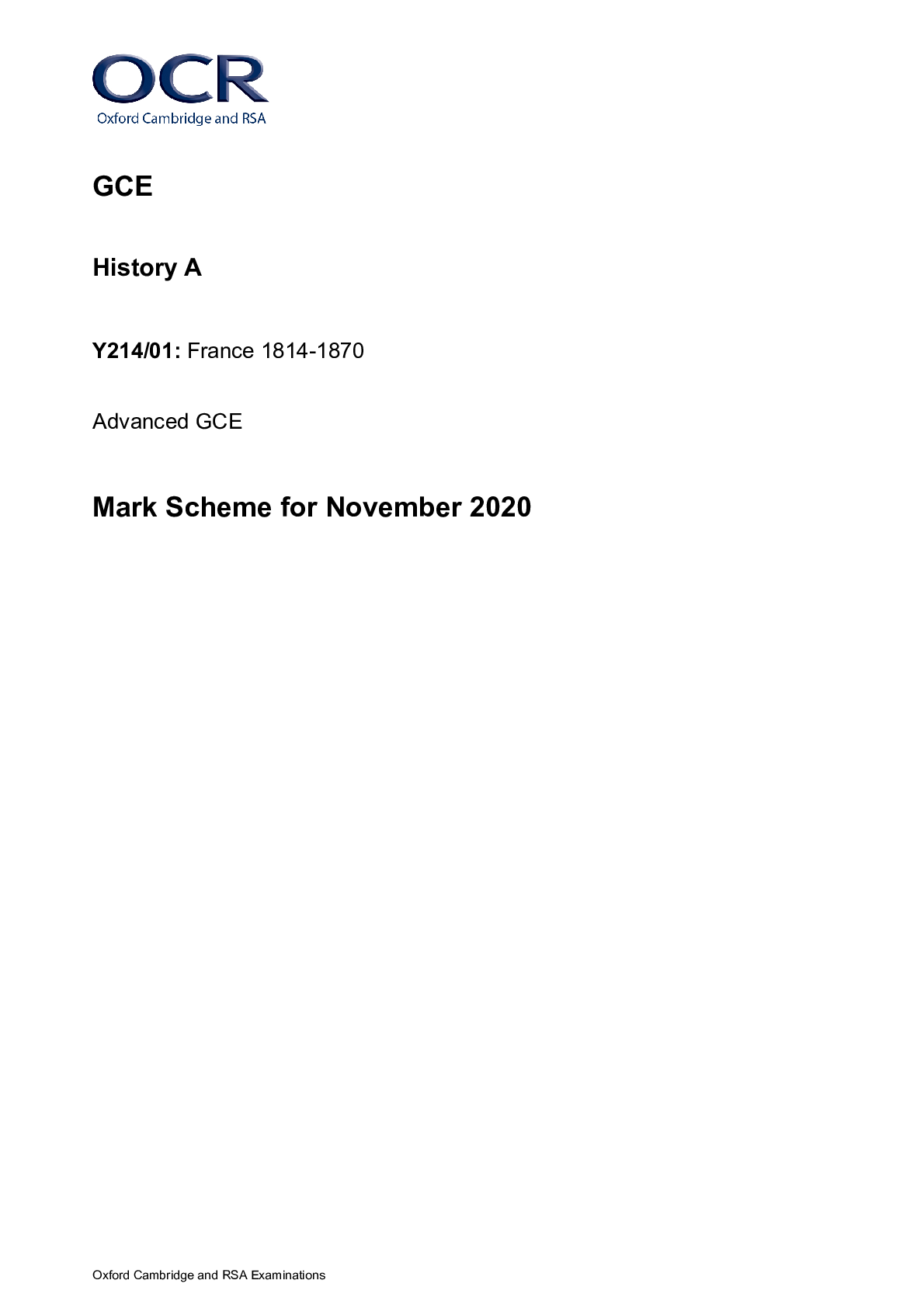



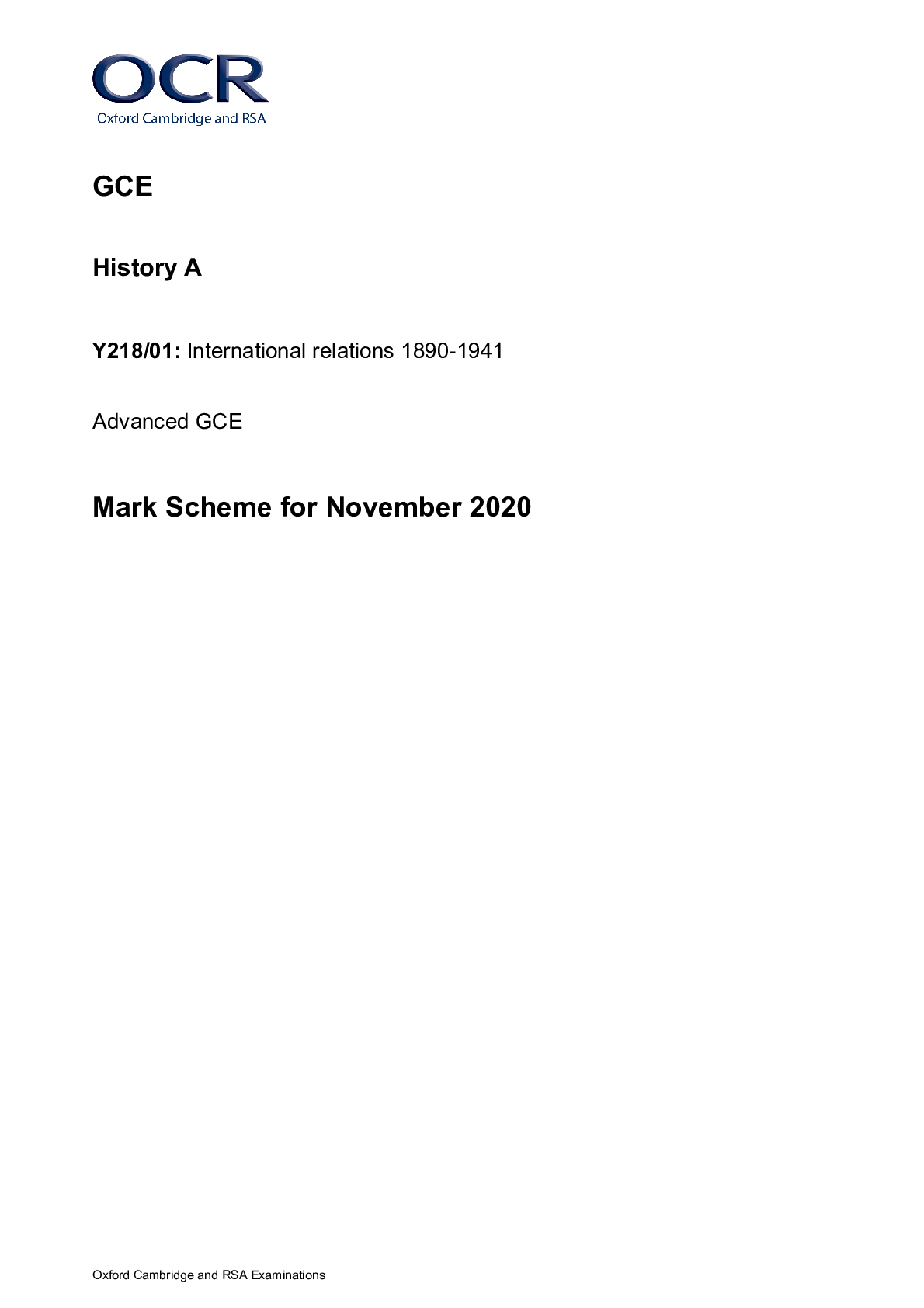
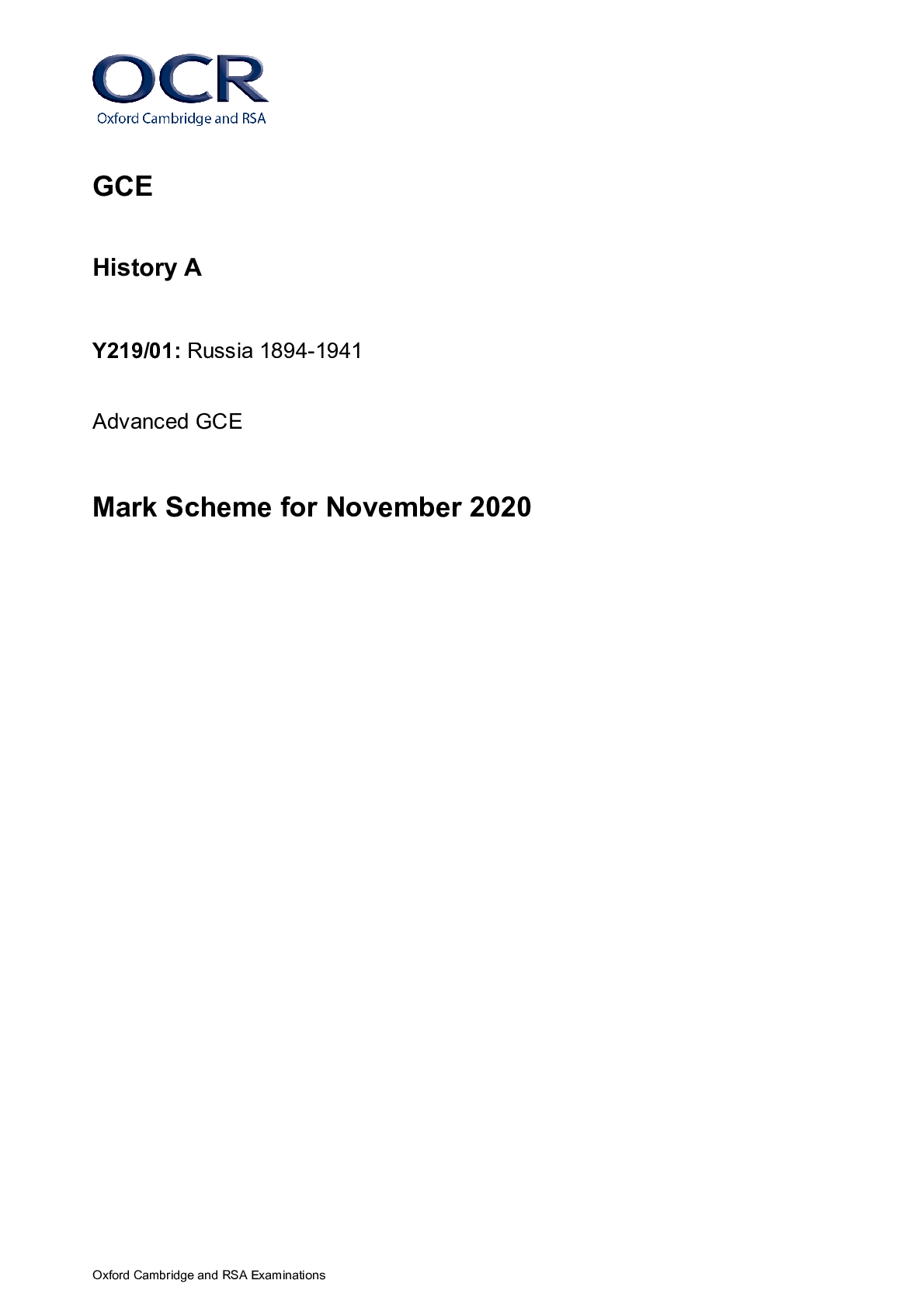







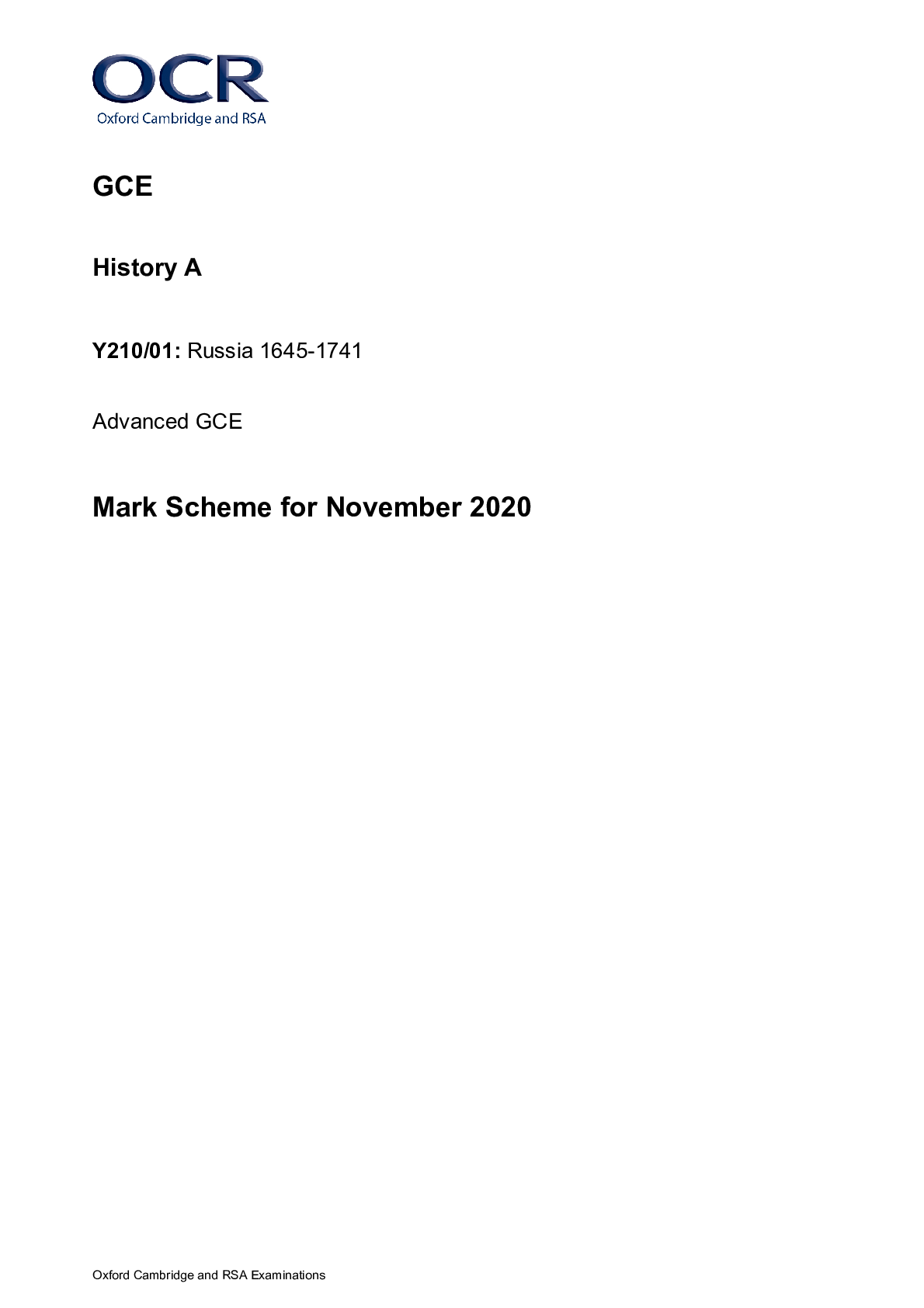


.png)

